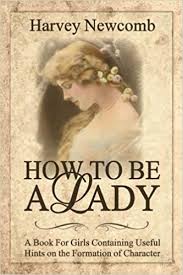National Etiquette Week
Listen to the Recess! Clip
| Author | Rita Smith |
| Air Date | 5/14/2001 |

National Etiquette Week Transcript
How to Be a Lady was written in 1854 and is broader than just an etiquette book since it includes advice on a wide variety of topics. It was written by Harvey Newcomb, who intended it for girls between the ages of 8 and 15. According to the preface, Mr. Newcomb hopes to offer some good advice for girls in an entertaining way so they can become “well-bred, intelligent, refined and good.” (p. 4)
The first few chapters center around the most important elements of behavior, obedience to God and obedience to parents. Then Newcomb moves on to the lesser, but still important, elements of good behavior including a discussion of good and bad habits.
One habit he detests is noisiness, defined as “talkativeness, loud laughing, humming patches of song-tunes, and in general a noisy bustling activity.” (p. 93) A talkative girl will tell all she knows,” Newcomb writes, “and all she can remember that she has ever heard anybody say, to everyone she meets. She will take up time and occupy the attention of others, in relating long, humdrum stories about matters and things which nobody cares to hear. You wait with impatience to hear the end of her story, that you may have a little quiet; but her tongue never stops, but, like the clapper of a mill, keeps up its incessant clack…. In listening to the talkative girl, I have often felt an involuntary apprehension for [her tongue], which is obliged to perform so much labor. It must be made of stern stuff, or it would wear out, or, at least, grow weary. It is a wonder,” he concludes, “that it does not [burst into flames] from [the] friction.” (94)
A good habit a young girl should cultivate is thoughtfulness. Newcomb includes detailed instructions in this section on how to handle a borrowed book. Although he warns that reading a book merely for amusement is a dangerous habit, he allows that reading for improvement is always time well spent. “A girl who has borrowed a book,” he writes, “should be careful to replace [it]…exactly as she found it. If she takes a book to read, she carries it with care, firmly grasped in her hand and avoids letting it fall or hitting it against any thing to bruise the cover. She holds it in such a manner as not to strain the back, nor crumple the leaves; if called away from her reading, she puts in a mark, shuts it up, and lays it in a safe place. …And when she has finished reading it, she carefully replaces it in the library, just where she found it. She does not place it wrong end upwards, nor the title towards the back of the shelf, but puts it in the place where it belongs, makes it stand straight, and shoves it back even with its fellows.” (p. 92) As a librarian, I must say, that advice warms my heart. .0
Source:
Newcomb, Harvey. How to Be a Lady: A Book for Girls, Containing Useful Hints on the Formation of Character. 14th ed. Boston: Gould and Lincoln; New York: Sheldon, Lamport, and Blakeman, 1854.